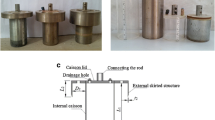Abstract
The suction caisson is a large top-closed cylindrical steel structure in diameter, short in length and much thinner in skirt wall thickness. The total resistance of the suction caisson during installation consists of the tip resistance and the skirt wall friction. However, since the thickness of the skirt wall is very small, the skirt wall friction may produce additional vertical stress and shear stress in soil at the skirt tip level, and this additional vertical stress and shear stress will contribute to the increase in the skirt tip resistance. At the same time, seepage induced by suction also causes the tip resistance to reduce significantly. A modified slip-line field is proposed in this study estimating the tip resistance in terms of the slip-line theory. The expression obtaining the minimum suction to install the suction caisson is also proposed in terms of the force equilibrium. In addition, the critical suction is determined based on the mechanism of sand piping. Thus, the maximum penetration depth of the suction caisson can be reached when the critical suction equals the minimum suction. Results from calculations of the minimum suction and the maximum penetration depth have been proved to be in a good agreement with the measured data.
Similar content being viewed by others
References
American Petroleum Institute (API) (1993). Recommended practice for planning, designing and constructing fixed offshore platforms, API RP 2A, American Petroleum Institute, Washington, D.C.
Andersen, K. H., Murff, J. D., Randolph, M. F., Clukey, E. C., Erbrich, C. T., Jostad, H. P., Hansen, M., and Supachawarote, C. (2005). “Suction anchors for deep water applications. Keynote lecture.” In: Proceedings of the International Symposium on Frontiers in Offshore Geotechnics, Perth, Western Australia, pp. 3–30.
Andersen, K. H., Jostad, H. P., and Dyvik, R. (2008). “Penetration resistance of offshore skirted foundations and anchor in dense sand,” Journal of Geotechnical and Geoenvironmental Engineering, Vol. 134, No. 1, pp. 106–116, DOI: 10.1061/(ASCE)1090-0241(2008)134:1(106).
Bye, A., Erbrich, C., Rognlien, B., and Tjelta, T. I. (1995). “Geotechnical design of bucket foundations.” In: Proceedings of the Offshore Technology Conference. Paper No. OTC 7793. 27th Ed., pp. 869–883, DOI: 10.4043/7793-MS.
Clausen, C. J. F. (1998). “Fundamentering av plattformer; Observasjonerog refleksjoner.” 16th Laurits Bjerrum Memorial Lecture, Norwegian Geotechnical Institute, Oslo.
Erbrich, C. T. and Tjelta, T. I. (1999). “Installation of bucket foundations and suction caissons in sand-geotechnical performance.” Proceedings of the 31th Annual Offshore Technology Conference, Houston: OTC 10990, pp. 725–735. DOI: 10.4043/10990-MS.
Hogervorst, J. R. (1980). “Field trials with large diameter suction piles.” Proc., Offshore Technology Conf., OTC 3817, 12th Ed., pp. 217–224, DOI: 10.4043/3817-MS.
Houlsby, G. T. and Byrne, B. W. (2005). “Design procedure for installation of suction caissons in sand,” Geotechnical Engineering, Vol. 158, No. 3, pp.135–144, DOI: 10.1680/geng.2005.158.3.135.
Harireche, O., Mehravar, M., and Alani, A. M. (2013). “Suction caisson installation in sand with isotropic permeability varying with depth,” Applied Ocean Research, Vol. 43, pp. 256–263, DOI: 10.1016/j.apor.2013.10.008.
Harireche, O., Mehravar, M., and Alani, A. M. (2014). “Soil conditions and bounds to suction during the installation of caisson foundations in sand,” Ocean Engineering, Vol. 88, pp. 164–173, DOI: 10.1016/j.oceaneng.2014.06.033.
Hu, Z. P., Wang, R., and Xia, X. B. (2015). “Modifying the formula of the ultimate bearing capacity of a shallow circular foundation,” Journal of Highway and Transportation Research and Development, Vol. 9, No. 1, pp. 1–7, DOI: 10.1061/JHTRCQ.0000419.
Hill, R. (1950). The Mathematical Theory of Plasticity, Clarendon Press, Oxford.
Ibsen, L. B. (2008). “Implementation of a new foundations concept for offshore wind farms.” In: Proceedings of the Nordisk Geoteknikermøte Nr. 15. NGM 2008, Sandefjord, Norway, pp. 19–33.
Jostad, H. P. and Andersen, K. H. (2006). “Potential benefits of using skirted foundations for jack-up platforms.” In: Proceedings of the Offshore Technology Conference. Paper No. OTC 18016, Houston. DOI: 10.4043/18016-MS.
Kim, D. S., Lee, S. T., and Kim, J. H. (2016). Centrifuge model tests on installation of suction caissons in sand. “Japanese Geotechnical Society Special Publication.” Vol. 4, No. 4, pp.73–77, DOI: 10.3208/jgssp.v04.k05.
Li, D. Y., Zhang, Y. K., Gao, Y. F., and Song, Y. J. (2012). “Model tests on penetration of suction anchors in medium-coarse sand,” Chinese Journal of Geotechnical Engineering, Vol. 34, No. 12, pp. 2278–2283. (in Chinese)
Meyerhof, G. G. (1951). “The ultimate bearing capacity of foundations,” Geotechnique, Vol. 2, No. 4, pp. 301–332, DOI: 10.1680/geot.1951. 2.4.301.
Terzaghi, K. (1943). Theoretical soil mechanics, New York: Wiley John.
Tjelta, T. I. (1995). “Geotechnical experience from the installation of the europipe jacket with bucket foundations.” In: Proceedings of the Offshore Technology Conference. Paper No. OTC 7795, DOI: 10.4043/7795-MS.
Tjelta, T. I., Guttormsen, T. R., and Hermstad, J. (1986). “Large scale penetration test at a deepwater site.” Proc., Offshore Technology Conf., OTC 5103, 18th Ed., 201–212, DOI: 10.4043/5103-MS.
Tran, M. N., Randolph, M. F., and Airey, D. W. (2005). “Study of seepage flow and sand plug loosening in installation of suction caissons in sand.” Proceedings of the Fifteenth International Offshore and Polar Engineering Conference, Seoul. pp. 516–521.
Tran, M. N. and Randolph, M. F. (2008). “Variation of suction pressure during caisson installation in sand,” Geotechnique, Vol. 58, No. 1, pp. 1–11, DOI: 10.1680/geot.2008.58.1.1.
Zhang, S. H., Zheng, Q. A., and Liu, X. A. (2004). “Finite element analysis of suction penetration seepage field of bucket foundation platform with application to offshore oilfield development,” Ocean Engineering, Vol. 31, pp. 1591–1599, DOI: 10.1016/j.oceaneng.2004.03.001.
Author information
Authors and Affiliations
Corresponding author
Rights and permissions
About this article
Cite this article
Wu, Y., Li, D., Zhang, Y. et al. Determination of Maximum Penetration Depth of Suction Caissons in Sand. KSCE J Civ Eng 22, 2776–2783 (2018). https://doi.org/10.1007/s12205-017-1469-x
Received:
Revised:
Accepted:
Published:
Issue Date:
DOI: https://doi.org/10.1007/s12205-017-1469-x



